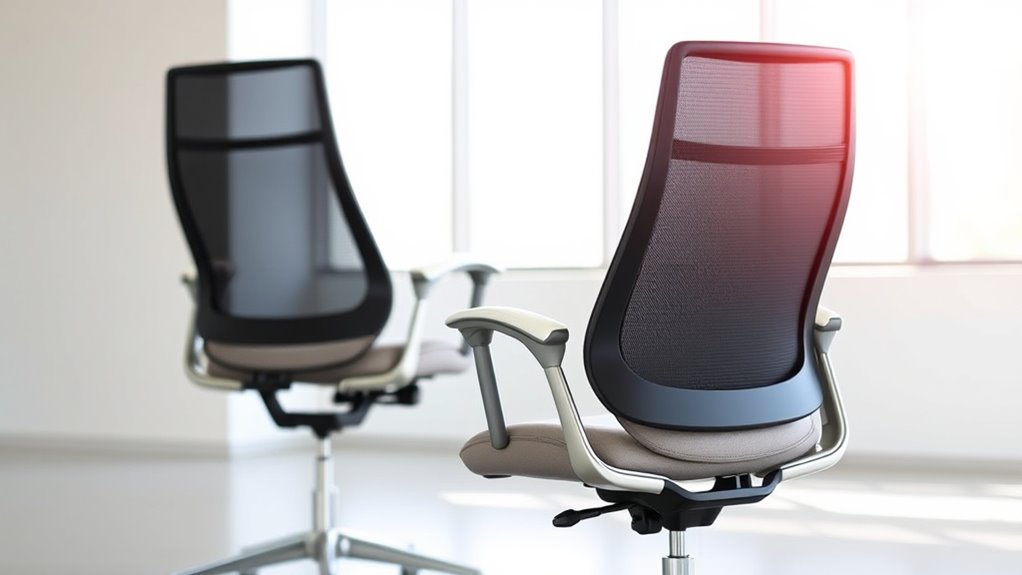An ergonomic chair designed for posture and ease helps keep your spine properly aligned and reduces strain. Look for features like adjustable height, lumbar support, and armrests that keep your shoulders relaxed. Proper support encourages a healthy sitting position and long-term comfort while minimizing fatigue. Investing in a chair that adapts to your body’s movements can improve your overall wellbeing. If you want to discover how to choose the best ergonomic seating, keep exploring.
Key Takeaways
- Ergonomic chairs provide adjustable lumbar support to maintain proper lower back curvature and spinal health.
- Adjustable seat height ensures feet rest flat and knees form a 90-degree angle, promoting better circulation.
- Customizable armrests and seat depth help reduce shoulder and leg strain, enhancing comfort.
- Tilt tension and lock features allow for natural movement and personalized support during long sitting periods.
- Proper ergonomic seating reduces fatigue, supports good posture, and encourages ease of movement for overall well-being.

Ergonomic seating is designed to support your body’s natural posture, helping you stay comfortable and reduce the risk of strain during long periods of sitting. When choosing a chair, focus on features that promote proper alignment, especially lumbar support and adjustable height. Lumbar support is vital because it maintains the curve of your lower back, preventing slouching and reducing pressure on your spine. A chair with built-in lumbar support encourages you to sit upright, which is healthier for your back over time. If the lumbar support is adjustable, you can customize the fit to match your lumbar curve precisely, guaranteeing that your lower back gets the support it needs most. This customization makes a significant difference in preventing discomfort and long-term back issues.
Proper lumbar support prevents slouching and reduces spinal pressure for long-lasting comfort and health.
Adjustable height is another essential feature because it allows you to set the chair at the most suitable level relative to your desk and computer screen. When your chair height is right, your feet rest flat on the floor, and your knees are at a 90-degree angle. This positioning promotes better circulation and reduces fatigue. You should also be able to adjust the seat height easily, so you can switch positions throughout the day, which helps prevent stiffness and promotes circulation. Proper height adjustment ensures your hips are level, which supports your lower back and encourages good posture. Additionally, choosing a chair with quality materials can enhance durability and comfort over time.
Beyond lumbar support and adjustable height, a good ergonomic chair adapts to your body’s movements. Look for a chair that offers adjustable armrests, seat depth, and tilt tension, so you can fine-tune the fit. When your armrests are adjustable, your shoulders stay relaxed, and you avoid unnecessary strain. Seat depth adjustment helps you maintain a small gap between the edge of the seat and behind your knees, promoting proper blood flow. Tilt tension and lock features allow you to lean back comfortably, while maintaining support.
Ultimately, ergonomic seating isn’t just about comfort; it’s about health. By prioritizing lumbar support and adjustable height, you actively protect your spine and promote better posture. These features enable you to maintain a natural, relaxed position throughout your workday, reducing fatigue and preventing discomfort. Investing in a chair with these adjustable and supportive features means you’re taking proactive steps toward a healthier, more comfortable workspace. When your seating is tailored to your needs, sitting for hours becomes easier and less taxing on your body, allowing you to focus on your tasks without distraction or pain.
Frequently Asked Questions
How Often Should I Adjust My Ergonomic Chair?
You should adjust your ergonomic chair regularly to maintain comfort and proper posture. Follow an adjusting schedule of every 30 to 60 minutes, especially during long work sessions. Use ergonomic checkpoints to assess your positioning—make small tweaks for your back, arms, and seat height. This proactive approach helps prevent discomfort and promotes better ergonomics, ensuring you stay comfortable and focused throughout your day.
Are Ergonomic Chairs Suitable for All Body Types?
They say, “One size doesn’t fit all,” and that’s true for ergonomic chairs. You’ll find many options with chair customization to suit different body types, ensuring comfort and support. While aesthetic design matters, it’s crucial to prioritize features that promote good posture. You should choose a chair that adapts to your body, offering proper lumbar support and adjustable settings, so it works well for you, no matter your size or shape.
What Materials Are Best for Long-Term Comfort?
When choosing materials for long-term comfort, you should look for options like memory foam and breathable mesh. Memory foam contours to your body, providing personalized support and reducing pressure points. Breathable mesh keeps air flowing, preventing overheating during extended use. Together, these materials enhance comfort, allowing you to sit comfortably for hours without discomfort or fatigue. Prioritize these materials to enjoy sustained comfort and support throughout your day.
Can Ergonomic Seating Improve Concentration and Productivity?
Some might think ergonomic seating doesn’t impact focus, but it actually does. When your posture is corrected, you experience less discomfort and distraction, allowing you to concentrate better. Ergonomic chairs promote posture correction, which enhances focus and productivity. By supporting your body properly, you can stay engaged longer, reducing fatigue and increasing efficiency throughout your workday. Prioritizing ergonomic seating directly boosts your ability to stay attentive and perform at your best.
How Do I Know if My Chair Offers Proper Lumbar Support?
To know if your chair offers proper lumbar support, check if it aligns with your lower back’s natural curve. When you sit, your lumbar support should fill the curve without forcing you into an unnatural position. Adjust the support if possible, ensuring it promotes good posture correction. If you experience discomfort or slouching, your chair likely lacks adequate lumbar support, which can negatively impact your posture over time.
Conclusion
Choosing ergonomic seating isn’t just about comfort—it’s about investing in your health and well-being. When you prioritize proper support, you’re giving your body a gift that keeps on giving, like a gentle guardian watching over your posture. So, why settle for less when the right chair can transform your workday into a healthier, more comfortable experience? Remember, your back deserves the best—don’t let poor seating steal your comfort or your health.









